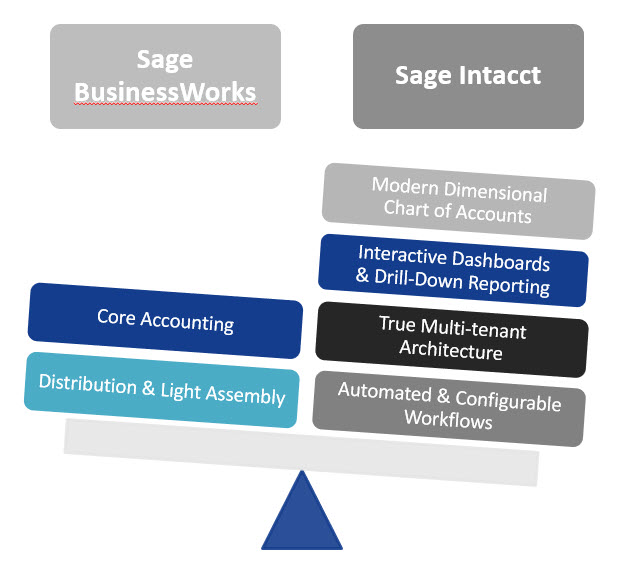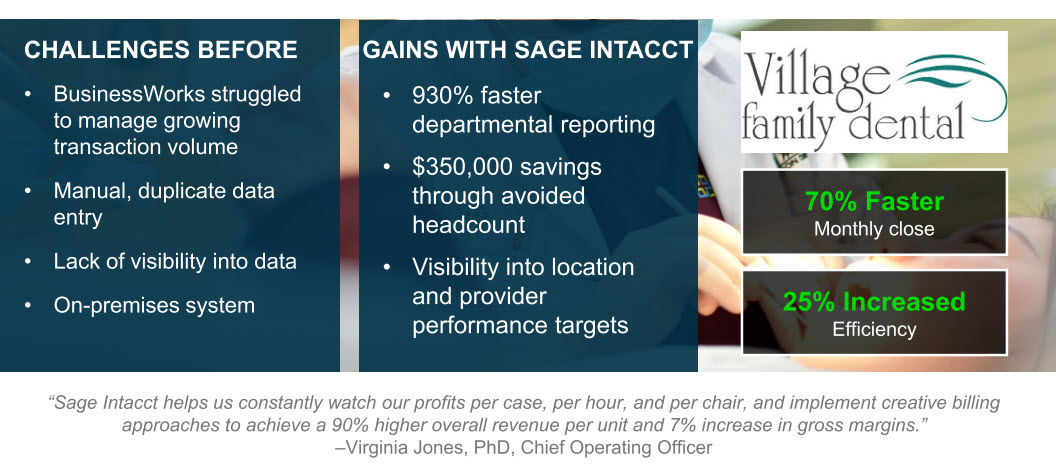As a Sage BusinessWorks user, your growth and success are at the heart of everything we do. We want to ensure that you have the right solution to position yourself for success at every stage of your business.
We are often asked to explain the key differences between Sage BusinessWorks vs Sage Intacct by customers that started out on BusinessWorks, and have experienced growth or the need for more advanced functionality.
DWD has been a Sage Software Certified Partner since 2001 and has many years of expertise with both Sage BusinessWorks and Sage Intacct.
Sage BusinessWorks vs Sage Intacct – Key Differences

Why companies using BusinessWorks switch to Sage Intacct
- Business has grown and there is a decline in speed and performance as database grows (performance-related issues).
- You’re doing too much of your reporting and manipulating data in Excel. You need real-time control and visibility over all business activities to minimize operating costs.
- With no centralized visibility or management across entities, multi-entity consolidations takes hours to days to complete in Excel causing closes to easily exceed 10 business days.
- Lack of automation has led you to rely on error-prone manual processes.
- Manual processes lead to delays or increases in headcount as business grows.
- Anywhere, anytime access for remote users. Accessing your system remotely isn’t possible or requires an expensive remote access server.
- Painful software upgrades that are often as expensive as a new implementation.
See Also: Sage 50 vs Sage Intacct
Village Family Dental’s Results with Sage Intacct
Sage BusinessWorks vs Sage Intacct Side by Side Comparison (updated 2025)
| SAGE BUSINESSWORKS | SAGE INTACCT | |
|---|---|---|
| Overall Strengths | User-friendly, solid core accounting, payroll and job costing functionality. Email reports as well as customer/vendor documents, ability to invoice through mail or email, user-or role-based security. | Born in the cloud, true multi-tenant architecture, modern dimensional chart of accounts, interactive dashboards and drilldown reporting provide instant visibility, automated, configurable workflows, deep vertical focus and automation of key processes. |
| Overall Weaknesses | Decreased performance as soon as approximately 10 users concurrently access. High volumes of data can slow down the system and/or lead to data corruption. Inability to customize data entry screens, add new fields, or add customized functionality. Limited access to 3rd party functionality. Limited ability to customize forms and reports. Only one costing method can be selected for inventory. | Operational functionality is not a perfect fit for those with manufacturing and advanced inventory needs. |
| Number of Users | Up to 45 | Unlimited |
| Performance & Scalability | Designed for a limited number of users and functions, simple business processes, few integrations to expand functionality. | Supports larger file sizes, companies and user counts, ability to modify software and workflow with scripting and screen customizations, many integrations available to enhance functionality. |
| Financial Management & Reporting | No dashboard functionality. Limited customization of standard reports. Report-writing add-on available to customize financials. Many reports redesigned for easier export to Word, Excel or in PDF format. | Modern dimensional chart of accounts, interactive dashboards and drilldown reporting provide instant visibility. |
| Ability to Customize | No customization ability. | Highly customizable system, you can tailor workflows, data fields, transaction definitions, invoices, report formats and much more. |
| Best Fit Industries | Financial, Distribution, Light Assembly | Professional services, Nonprofits, Healthcare, Mental & Behavioral Health, Colleges & Universities, Restaurants, Franchise Business, Financial Services |
| Best Fit Company Size | Small to Medium | Small to Large |
| Deployment Options | On-Premise, Hosted Server | Cloud/Software as a Service (SaaS) model. |
| Ease of Implementation | Fairly easy to implement. | Smaller software solutions tend to be easier to implement because there is much less flexibility to tailor the system to specific needs. |
| Avg Implementation Timeframe | 1 to 2 months | The average implementation time for Sage Intacct is 3 months. (2 months for the actual implementation + 1 month for testing). |
| Avg Implementation Cost | $3,000 – $10,000 | 1-2 times the cost of the software. |
| Pricing Model | License purchase with annual maintenance plan or subscription; concurrent user licenses. | Subscription – single user with single entity starts at $8,580 per year. |
| Annual Maintenance Cost | $1,000 – $2,250 | Subscription pricing includes 4 automatic upgrades per year as well as hosting, maintenance, backups and security. |
Sage BusinessWorks vs Sage Intacct Comparison FAQs
Next Step: Evaluate the Pros and Cons
Since we’re certified on Sage BusinessWorks and Sage Intacct, our familiarity with both products means that we can help you compare the pros and cons of Sage Intacct vs Sage BusinessWorks for your specific operational needs and business goals in mind. If it’s not the right move, we’ll tell you. If it is the right move, we’ll be there to help you usher in all the benefits of cloud technology.
Take advantage of our free Software Needs Assessment to help you find the best software for your unique needs, whether it be Sage BusinessWorks or Sage Intacct. Our experts are here to answer your questions and provide objective advice so you can find the right solution.

